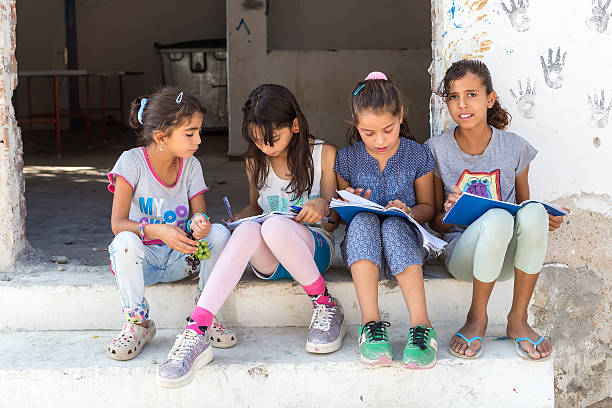Teaching Global Empathy: Strategies for Elementary Teachers to Address the Plight of Syrian Child Victims of Conflict

s2dikdas.fip.unesa.ac.id SURABAYA – The ongoing conflict in Syria has left millions of children vulnerable to violence, displacement, and deprivation. This humanitarian crisis has captured the world's attention, yet its impact on young learners in Indonesia remains largely overlooked. Teachers, as the architects of future generations, hold a pivotal role in fostering empathy and awareness about global issues such as the plight of Syrian child victims.
The Role of Educators in
Global Empathy
Elementary teachers are at the
forefront of shaping students' values and attitudes. Introducing global issues
like the Syrian crisis to young learners may seem daunting, but it is a crucial
step toward building a generation that is more compassionate and globally
conscious. Empathy, a cornerstone of global citizenship, can be cultivated
through innovative strategies that align with educational goals while
maintaining age-appropriate sensitivity.
The starting point is integrating
real-world issues into the curriculum. Teachers can design lessons that connect
the struggles of Syrian children to universal themes like friendship,
resilience, and hope. This approach helps students relate to these distant
experiences, making them more tangible and meaningful. For instance,
storytelling sessions featuring age-appropriate narratives about Syrian
children can spark curiosity and encourage discussions about shared humanity.
Strategies for Teaching
Empathy
- Interactive Storytelling - Storytelling is a
powerful tool for building empathy. By sharing stories of Syrian children
who have overcome adversity, teachers can encourage students to step into
the shoes of others. These stories should be carefully curated to avoid
graphic content while highlighting resilience and hope. After
storytelling, teachers can facilitate discussions that prompt students to
reflect on how they would feel in similar situations, fostering emotional
connection and understanding.
- Creative Arts Integration - Art projects
inspired by the experiences of Syrian children can help students express
their feelings and connect with the stories on a deeper level. For
example, students can create drawings or write letters of encouragement to
hypothetical Syrian peers. Such activities not only nurture creativity but
also provide an outlet for empathy to grow in a safe and supportive
environment.
- Role-Playing and Simulations - Role-playing
activities enable students to experience scenarios that mimic the
challenges faced by Syrian children. For instance, a simulation game could
involve limited resources or navigating displacement. These activities
allow students to grasp the complexities of conflict in a way that is
engaging and thought-provoking.
- Collaborative Learning Projects - Encouraging
students to work on group projects focused on understanding global issues
fosters collaboration and empathy. For example, students can research the
cultural heritage of Syria or the impact of conflict on education.
Presenting their findings to classmates can build a sense of shared
responsibility for global problems.
- Global Pen Pal Programs - If feasible,
establishing communication with schools in other countries can expose
students to diverse perspectives. Though direct interactions with Syrian
students may not always be possible, pen pal programs with children from
other regions affected by conflict can achieve similar goals.
Challenges in Implementing
Empathy-Based Education
Despite the benefits, teaching
global empathy comes with its challenges. Educators must strike a balance
between informing students and ensuring they are not overwhelmed by the harsh
realities of conflict. Sensitivity is key; lessons must be designed to build
awareness without causing distress. Teachers also need adequate training and
resources to handle these topics effectively.
Another challenge is the
potential resistance from parents or guardians who may question the relevance
of discussing global issues in an elementary classroom. Educators must
communicate the value of these lessons, emphasizing how they align with broader
educational objectives such as critical thinking, cultural appreciation, and
social responsibility.
Encouraging Sustainable
Empathy
Empathy education should not be
limited to a single lesson or activity. It requires consistent reinforcement
through various subjects and school activities. Integrating global themes into
subjects like social studies, language arts, and even science ensures that
empathy becomes a recurring theme in students' learning journeys.
Teachers can also organize events
such as Global Awareness Day, where students learn about different cultures and
global challenges. Inviting guest speakers, organizing fundraising activities
for humanitarian aid, or showcasing student projects related to global issues
can enhance the learning experience.
The Impact on Students
Teaching global empathy has a
profound impact on students' personal and social development. It broadens their
horizons, helping them understand the interconnectedness of the world and their
role in it. Students who develop empathy early are more likely to grow into
compassionate leaders and active citizens who contribute positively to society.
By learning about the struggles
of Syrian children, Indonesian students can appreciate the privileges they
often take for granted. This understanding fosters gratitude and a sense of
responsibility to support those in need. It also prepares students to navigate
a globalized world where collaboration and understanding across cultures are
essential.
The plight of Syrian child
victims of conflict is a stark reminder of the inequalities and challenges that
persist in the world. While addressing such complex issues may seem beyond the
scope of elementary education, the reality is that teachers have the power to
make a difference. By fostering empathy and awareness among young learners,
they lay the foundation for a more compassionate and globally conscious
generation.
Educators must embrace their role
as catalysts for change, leveraging innovative strategies to teach empathy in a
way that resonates with students. In doing so, they not only enrich the lives
of their students but also contribute to a future where empathy and global
citizenship are valued and practiced by all.
Author: Annas Solihin, S.Pd.
Photo Documentation: istock